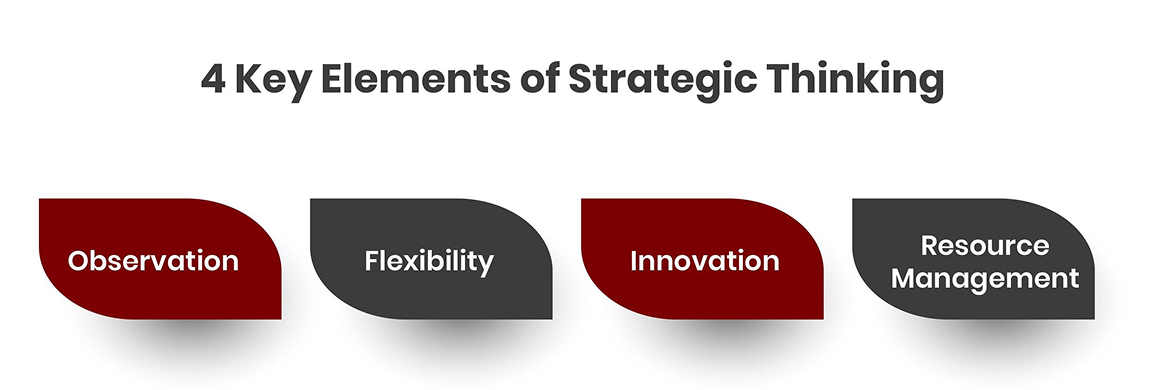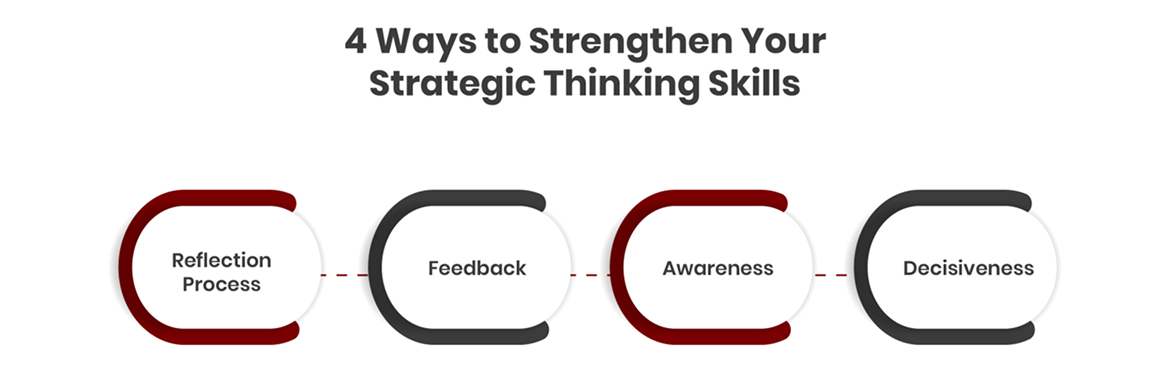Strategic thinking is essential for making informed decisions that drive business success. This skill enables you to assess information, evaluate situations, and develop effective plans. This article explores the importance of strategic thinking, and how to improve your abilities. With stronger strategic thinking skills, you can make choices that give your company an advantage.
Strategic thinking is intentionally and logically evaluating information to make decisions. It involves identifying risks, trends, resources, and opportunities that can impact plans and goals. Strategic thinkers take a big-picture view to create frameworks that help them solve problems. They aim to give their organizations direction through flexibility, awareness, and systematic planning.
Strategic thinking is critical for achieving long-term success and navigating complex challenges. It serves as a guiding compass for individuals and organizations in an ever-changing world. There are several key reasons why strategic thinking holds paramount importance:
In a dynamic environment characterized by technological innovations, shifting market landscapes, and regulatory changes, the ability to adapt is vital. Strategic thinking enables adaptability by:
Strategic thinking entails proactively assessing an organization's vulnerabilities, competitive threats, and potential disruptions. Key risk mitigation benefits include:
Complex challenges demand structured and creative problem-solving capabilities. Strategic thinking facilitates this through:
Navigating uncertainty and complexity requires sound judgement to make choices that will pay dividends over the long haul. Strategic thinking strengthens decision making by:
While strategic thinking skills apply to roles across an organization, they are indispensable for leadership. The far-reaching influence of strategic leaders stems from their ability to:
With multifaceted challenges on the rise, strategic thinking serves as an indispensable compass towards progress and success. By arming individuals and institutions with the ability to adapt, take risks, solve problems, make decisions and lead strategically, this future-focused skill set provides a competitive edge to thrive amid turbulence. Though demanding commitment and diligence, nurturing strategic thinking skills holds invaluable dividends.
The following are key elements of strategic thinking:

Strategic thinking relies heavily on careful and discerning observation. Strategic leaders must closely monitor both internal operations and external trends, gathering pertinent insights that will inform major decisions and shape long-term plans. This requires paying attention to subtle signals and details that may prove consequential.
Leaders should observe industry trends, economic conditions, competitor moves, customer preferences and more to spot patterns, changes, and opportunities. Internally, they must stay attuned to organizational performance metrics, employee sentiment, cultural dynamics and areas needing improvement. Ongoing learning through extensive yet acute observation provides the vital perceptual inputs for devising strategies aligned with reality.
Leaders must notice not just problems but emerging best practices worth emulating. Keen powers of observation allow strategic thinkers to operate from a position of understanding rather than assumption. They can base choices on actual evidence of what works, what doesn’t and what new prospects exist. The deeper the observational insights, the more informed the strategic response can be. This builds the knowledge foundation upon which viable strategies are constructed.
Strategic plans rarely unfold precisely as intended. In an ever-changing world, circumstances tend to deviate from expectations. Competitor moves, customer preferences, market trends, technological shifts and other factors create fluid conditions. This turbulence demands flexibility in strategic thinking and execution.
Rather than rigid adherence to predetermined tactics, real-world strategy requires adaptable implementation, able to capitalize on emerging opportunities. A fixation on initial plans often proves counterproductive when conditions change. Strategic thinkers recognize the need for built-in flexibility, establishing a vision and directional objectives while empowering managers to fluidly adjust specific tactics as realities shift.
This strategic agility allows for responding to surprises and better leveraging changing dynamics. As new information emerges, tactics can shift without compromising overarching goals. Built-in flexibility fosters quicker reactions, allowing strategies to evolve as needed. This prevents wasted resources from forcing ill-fitting plans. An agile strategy can nimbly dance with changing conditions for greater alignment with reality.
Forward-looking strategic thinking demands innovation, not mere replication of past approaches. In dynamic environments, strengths can quickly become obsolete. Strategic leaders must foster innovative thinking to spur the next competitive advantage rather than fight the last war.
This requires an organizational culture welcoming novel ideas and creative solutions. Innovation can happen at all levels when people feel empowered to think differently. An atmosphere valuing imagination over convention encourages experimentation and informed risk-taking that breeds strategic innovation.
Thoughtful innovation also requires connecting insights across domains, blending once-separate approaches for fresh and functional new syntheses. Strategic thinkers excel at linking previously unconnected dots, devising unexpected yet pragmatic solutions. This Blue Ocean Strategy thinking allows new markets to open and the disruption of existing ones via strategic innovation.
All organizations contend with finite resources – capital, time, attention, talent – amidst unlimited options. Strategic thinkers must therefore make decisions about optimal resource allocation aligned to strategic priorities. This requires insight into projected returns on investment, opportunity costs and output implications of various resource deployment options.
Strategic resource management entails more than merely guarding against overextension. Savvy leaders deliberately direct resources into mission-critical initiatives with the highest potential strategic impact while starving less consequential ones. This focuses efforts on executing strategic priorities rather than getting spread thin across too many competing goals.
Clever resource leverage can also aid strategy. Strategic thinkers creatively multipurpose resources, repurposing existing assets in service of strategic aims. They extract more utility from resources by thinking expansively about uses beyond status quo applications. Rigorous strategic resource management lends itself to greater organizational agility, productivity and mission fulfillment.
Improving strategic thinking requires intentional effort and practice. The following are key ways to enhance strategic thinking skills:

Strategic thinkers set aside dedicated time for reflecting on information, analyzing data, and carefully considering new ideas or alternate perspectives. Reflection allows you to zoom out and identify connections between wider trends, organizational goals, competitive landscape, and other variables that impact strategic planning.
During the reflection process, it is important to examine challenges and opportunities from different views. Looking at a situation through different lenses enables you to surface assumptions, reconsider initial reactions, and gain a more rounded perspective. Deep reflection ultimately strengthens critical thinking capabilities that are crucial for sharp and effective strategy.
Specifically, you can improve strategic thinking through reflection by:
Actively seeking input through feedback is invaluable for improving strategic thinking capabilities. Feedback offers perspectives and insights you may not have previously considered. By asking peers, mentors, stakeholders, and even opponents to share constructive criticism, you open yourself to hearing hard truths and revelations about flaws in your thinking.
It takes humility to genuinely listen without being defensive. However, you stand to gain revealing knowledge gaps through the feedback process. Also, varying vantage points can highlight nuances you’d neglected to account for. Strategic leaders use input to make better informed planning choices aligned to their organization's best interest.
Concrete ways to utilize feedback for better strategic thinking include:
Developing self-awareness and deepening understanding of human psychology and behavior are cornerstones for improving strategic thinking. You can more accurately predict responses from competitors, customers, or your own teams when you grasp core human motivations and typical biases that skew judgment.
Strategic thinkers make a point to learn about:
With heightened awareness of these human factors, you can carefully examine your own tendencies and blind spots when making high-stakes choices. This self-insight lets you override inclinations in favor of options better aligned to overarching strategy.
A crucial element of strategic thinking is decisiveness - the ability to make clear choices in alignment with defined targets and then resolutely commit, without second-guessing or wavering. This decisiveness is founded on thoroughly gathering sufficient information beforehand and utilizing analytical skills to evaluate data.
Input from experts and objective analysis lend confidence in decision-making. But there comes a point where you must decide with conviction rather than perpetually deliberating. Without decisiveness, strategic momentum is impeded. Committed execution where everyone understands the playbook is critical for breakthrough results.
You demonstrate decisiveness as a strategic thinker when you:
Staying resolutely on-track builds trust and belief while reinforcing the strengths behind your chosen strategy. Decisiveness paired with flexibility to update approaches based on outcomes helps propel organizations toward desired targets.
With focus and practice, leaders can strengthen strategic thinking abilities over time. Approach decisions systematically. Weigh evidence, risks and rewards fully. Embrace innovation and be ready to shift as conditions change. Companies need strategic leaders to navigate uncertainty and set them apart from rivals. Use these tips to guide your organization toward its highest potential.

CredBadge™ is a proprietary, secure, digital badging platform that provides for seamless authentication and verification of credentials across digital media worldwide.
CredBadge™ powered credentials ensure that professionals can showcase and verify their qualifications and credentials across all digital platforms, and at any time, across the planet.

Keep yourself informed on the latest updates and information about business strategy by subscribing to our newsletter.